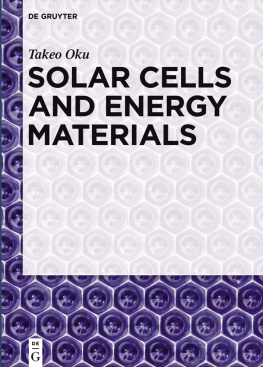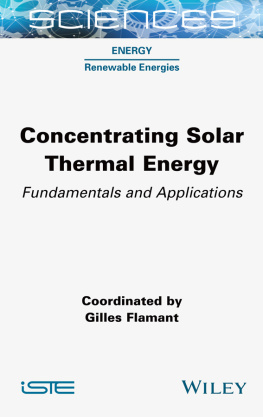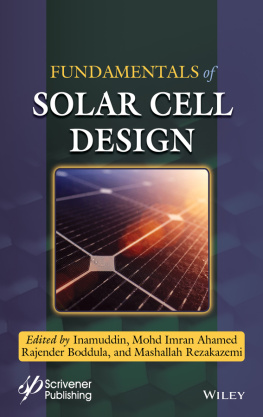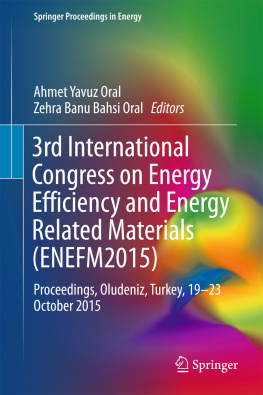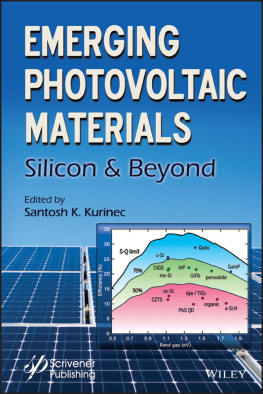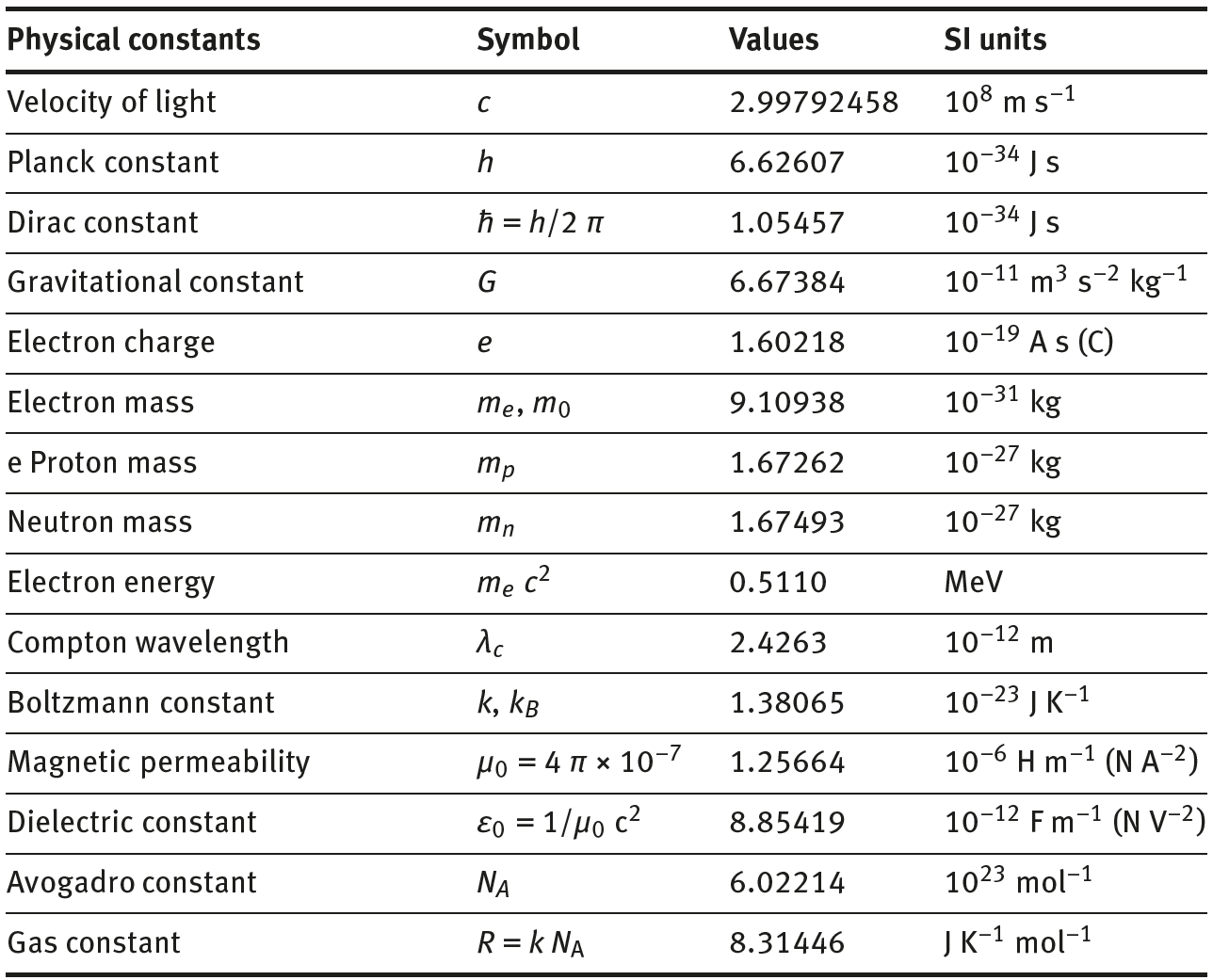Contents
Guide

Takeo Oku
Solar Cells and Energy Materials
Also of Interest
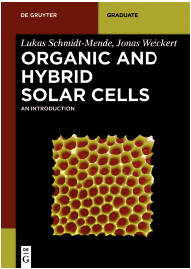
Organic and Hybrid Solar Cells
An Introduction
Schmidt-Mende, Weickert (Eds.), 2016
ISBN 978-3-11-028318-1, e-ISBN 978-3-11-028320-4
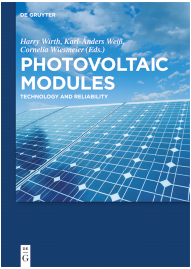
Photovoltaic Modules
Technology and Reliability
Wirth, Wei, Wiesmeier, 2016
ISBN 978-3-11-034827-9, e-ISBN 978-3-11-034828-6

Solar Energy and Technology
Volume 1: English-German Dictionary / Deutsch-Englisch Wrterbuch
Mijic, 2016
ISBN 978-3-11-047575-3, e-ISBN 978-3-11-047717-7
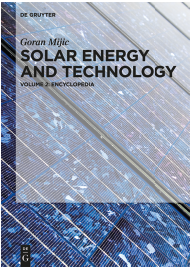
Solar Energy and Technology
Volume 2: Encyclopedia
Mijic, 2018
ISBN 978-3-11-047577-7, e-ISBN 978-3-11-047721-4
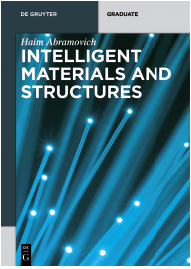
Intelligent Materials and Structures
Abramovich, 2016
ISBN 978-3-11-033801-0, e-ISBN 978-3-11-033802-7
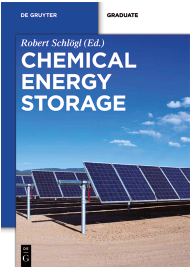
Chemical Energy Storage
Schlgl (Ed.), 2012
ISBN 978-3-11-026407-4, e-ISBN 978-3-11-026632-0

Author
Prof. Takeo Oku
The University of Shiga, Prefecture Japan
Department of Materials Science
Hassaka 2500, Hikone
Shiga 522-8533, Japan
oku@mat.usp.ac.jp
ISBN 978-3-11-029848-2
e-ISBN (PDF) 978-3-11-029850-5
e-ISBN (EPUB) 978-3-11-038106-1
Set-ISBN 978-3-11-041209-3
Library of Congress Cataloging-in-Publication Data
A CIP catalog record for this book has been applied for at the Library of Congress.
Bibliographic information published by the Deutsche Nationalbibliothek
The Deutsche Nationalbibliothek lists this publication in the Deutsche Nationalbibliografie;
detailed bibliographic data are available on the Internet at http://dnb.dnb.de.
2017 Walter de Gruyter GmbH, Berlin/Boston
Cover image: Takeo Oku
www.degruyter.com
Preface
Let there be light. These words appear at the beginning of Genesis in the Old Testament. Advanced cosmological science has likewise shown that the universe started from a Big Bang 13.7 billion years ago. Light is an elemental root of our universe. The flow of time that we feel in what we perceive to be the present is an effect of the close relationship between light and matter, and time does not flow by itself. Quantum teleportation utilizing the connected spins of quantum particles at a distance results from principles that still remain unknown to contemporary scientists. Light has also not yet been entirely clarified by the advances of contemporary science, and several aspects of it remain unexplained.
On the other hand, light is essential to our everyday life in contemporary society. Light contains energy and information simultaneously, and most new electronic apparatuses, such as mobile phones, laptop computers, DVD players or satellite communications, function in ways closely connected to light.
After the big earthquake in Japan in 2011, all nuclear reactors in Japan were stopped, and some of them had already been closed previously. Saving electricity is promoted both in both industries and ordinary homes, and the worlds energy problem has become a very familiar one in our everyday lives. Although Japans energy self-sufficiency was 58 %in 1960, it had been significantly reduced to only 4 %by 2014. In other words, 96% of the energy used in Japan depends on the import of materials such as oil, coal, liquefied natural gas and uranium, a fact that suggests improvements are needed to the current imbalance in supply and demand. Energy problems resulting from dependence on fossil fuels, which are limited energy resources, will soon be an inescapable issue all over the world. The author would be very pleased if the present book is helpful in solving future energy problems.
I would like to acknowledge many of my colleagues for their support, as follows: Atsushi Suzuki, Tsuyoshi Akiyama, Kenji Kikuchi, Taisuke Matsumoto, Akihiro Takeda, Akihiko Nagata, Kazuya Fujimoto, Junya Nakagawa, Hiroki Kidowaki, Nariaki Kakuta, Kazumi Yoshida, Masato Kanayama, Ryosuke Motoyoshi, Haruto Maruhashi, Masahito Zushi, Yuya Ohishi, Kohei Suzuki, Takuya Kitao, Taishi Iwata, Tatsuya Noma, Kazuma Kumada, Satoru Hori, Makoto Iwase, Yuma Imanishi, Yuji Ono, Kengo Kobayashi, Shiomi Kikuchi, Katsuhisa Tokumitsu, Mie Terada, Kouichi Hiramatsu, Masashi Yasuda, Yasuhiro Shirahata, Youichi Kanamori, Mikio Murozono, Yasuhiro Yamasaki, Mika Nakamura, Masahiro Yamada, Sakiko Fukunishi, Kazufumi Kohno, Misaki Fukaya, Yoshikazu Takeda, Akio Shimono, Eiji sawa, Yasuhiko Hayashi, Tetsuo Soga, Tatsuo Oku, Ichihito Narita, Masaki Kuno, Naruhiro Koi, Atsushi Nishiwaki, Tadachika Nakayama, Katsuaki Suganuma and Brian D. Josephson. Thanks for excellent collaborative works, useful discussion, providing samples and experimental help. In addition, some figures were drawn after revision of original figures from some books and websites and I would like to offer my appreciation for this material. I would also like to give thanks for the financial support I received from The University of Shiga prefecture, Satellite Cluster Program of the Japan Science and Technology Agency, and a Grant-in-Aid for Scientific Research. Finally, Id like to thank warmly Ria Fritz, Karin Sora, Anne Hirschelmann, Kelly Bescherer, Stefan Sossna, and Julia Lauterbach, who handled the production of this book.
November 2016, Takeo Oku
Table for physical constants
| Physical constants | Symbol | Values and units |
| Angstrm | A | 0.1 nm = 10 m |
| Electron volt | eV | 1.60218 10 J |
| Wavelength of 1 eV photon | 1239.84 nm |
| Standard atmosphere | atm | 1.01325 10 Pa |
Periodic table
1Energy
1.1What is energy?
The word energy can have the following meanings:
- The capacity for work that a certain system potentially has.
- The ability to do physical work.
- A useful resource for human society.
- A resource required for physical or mental activity.

